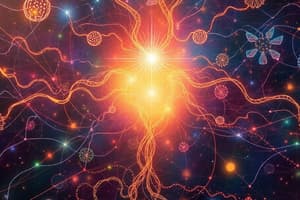Podcast
Questions and Answers
What role do olfactory hairs play in the process of smell?
What role do olfactory hairs play in the process of smell?
- They are responsible for the regeneration of olfactory neurons.
- They initiate action potentials in olfactory neurons. (correct)
- They dissolve odorants to facilitate their receptor binding.
- They serve as the primary receptors for all odorants.
How often are olfactory neurons replaced in the olfactory epithelium?
How often are olfactory neurons replaced in the olfactory epithelium?
- Once a year
- Every two months (correct)
- Every six months
- Every month
What is the function of olfactory vesicles found at the ends of olfactory neuron dendrites?
What is the function of olfactory vesicles found at the ends of olfactory neuron dendrites?
- To enhance the ability to dissolve odorants in mucus.
- To protect the neuron from damage.
- To transport odorants along the neuron.
- To increase the surface area for receptor sites. (correct)
What is the relationship between odorants and olfactory receptors?
What is the relationship between odorants and olfactory receptors?
Where is the olfactory epithelium located?
Where is the olfactory epithelium located?
What is the total number of different smells that humans can detect?
What is the total number of different smells that humans can detect?
Which structure does olfactory neurons pass through to reach the olfactory bulbs?
Which structure does olfactory neurons pass through to reach the olfactory bulbs?
Which part of the brain does olfactory information go to without passing through the thalamus?
Which part of the brain does olfactory information go to without passing through the thalamus?
Which types of cells are primarily involved in the olfactory sensory pathway?
Which types of cells are primarily involved in the olfactory sensory pathway?
What is the primary role of secondary olfactory areas in the brain?
What is the primary role of secondary olfactory areas in the brain?
What process enhances adaptation in the olfactory pathway?
What process enhances adaptation in the olfactory pathway?
How do olfactory neurons relay information to the brain?
How do olfactory neurons relay information to the brain?
What is the role of G proteins in olfactory receptor activation?
What is the role of G proteins in olfactory receptor activation?
Which type of papillae contains the most sensitive taste buds?
Which type of papillae contains the most sensitive taste buds?
What is the primary function of microvilli in taste cells?
What is the primary function of microvilli in taste cells?
Which part of the tongue is most sensitive to salty tastes?
Which part of the tongue is most sensitive to salty tastes?
How often are taste cells replaced within the taste buds?
How often are taste cells replaced within the taste buds?
Which taste type is associated with the highest sensitivity to alkaloids?
Which taste type is associated with the highest sensitivity to alkaloids?
What role do testants play in taste perception?
What role do testants play in taste perception?
Which of the following statements about filiform papillae is correct?
Which of the following statements about filiform papillae is correct?
How do texture and temperature affect taste perception?
How do texture and temperature affect taste perception?
What is the primary function of the sclera in the eye?
What is the primary function of the sclera in the eye?
Which of the following statements about the cornea is true?
Which of the following statements about the cornea is true?
What role does the iris play in the function of the eye?
What role does the iris play in the function of the eye?
Which part of the vascular tunic is involved in controlling the shape of the lens?
Which part of the vascular tunic is involved in controlling the shape of the lens?
What is the primary function of the pigmented layer of the retina?
What is the primary function of the pigmented layer of the retina?
What type of muscle is involved in the function of the sphincter pupillae?
What type of muscle is involved in the function of the sphincter pupillae?
Which structure in the eye is responsible for producing aqueous humor?
Which structure in the eye is responsible for producing aqueous humor?
What are the primary cell types found in the neural layer of the retina?
What are the primary cell types found in the neural layer of the retina?
What area of the retina is responsible for the greatest visual acuity?
What area of the retina is responsible for the greatest visual acuity?
Which structure in the eye is responsible for focusing light on the retina?
Which structure in the eye is responsible for focusing light on the retina?
What happens to light once it strikes the retina?
What happens to light once it strikes the retina?
What is the role of the optic nerve in vision?
What is the role of the optic nerve in vision?
Which component of the eye has a blind spot due to the exit of nerve processes?
Which component of the eye has a blind spot due to the exit of nerve processes?
What is the electromagnetic spectrum?
What is the electromagnetic spectrum?
Which structure in the eye primarily determines the amount of light entering?
Which structure in the eye primarily determines the amount of light entering?
What initiates the action potentials in olfactory neurons?
What initiates the action potentials in olfactory neurons?
Which ion channels are opened as a result of cyclic AMP in olfactory cells?
Which ion channels are opened as a result of cyclic AMP in olfactory cells?
What is the main purpose of the olfactory vesicles?
What is the main purpose of the olfactory vesicles?
How are basal cells related to olfactory neurons?
How are basal cells related to olfactory neurons?
What is the primary function of the olfactory epithelium?
What is the primary function of the olfactory epithelium?
Which step follows the activation of adenylate cyclase in the olfactory process?
Which step follows the activation of adenylate cyclase in the olfactory process?
What happens to odorants after they dissolve in mucus?
What happens to odorants after they dissolve in mucus?
Which molecular structure is associated with each odorant receptor molecule?
Which molecular structure is associated with each odorant receptor molecule?
What taste are humans most sensitive to?
What taste are humans most sensitive to?
Which cranial nerves are involved in the taste pathways?
Which cranial nerves are involved in the taste pathways?
Where do the fibers from the tractus solitarius extend to in the taste pathway?
Where do the fibers from the tractus solitarius extend to in the taste pathway?
What structure in the eye helps retain the shape of the eyelid?
What structure in the eye helps retain the shape of the eyelid?
Which of the following is NOT considered an accessory structure of the eye?
Which of the following is NOT considered an accessory structure of the eye?
How many extrinsic eye muscles are attached to each eye?
How many extrinsic eye muscles are attached to each eye?
What is the function of eyelashes?
What is the function of eyelashes?
Which parts of the brain do neurons from the thalamus project to?
Which parts of the brain do neurons from the thalamus project to?
Flashcards
Olfactory neurons
Olfactory neurons
Sensory neurons in the nose that detect odors.
Olfactory epithelium
Olfactory epithelium
Tissue lining the superior nasal cavity, containing olfactory receptors.
Olfactory vesicles
Olfactory vesicles
Enlarged ends of olfactory neurons' dendrites.
Odorants
Odorants
Signup and view all the flashcards
Olfactory hairs
Olfactory hairs
Signup and view all the flashcards
What is olfaction?
What is olfaction?
Signup and view all the flashcards
Where is the olfactory epithelium located?
Where is the olfactory epithelium located?
Signup and view all the flashcards
How many olfactory neurons are there?
How many olfactory neurons are there?
Signup and view all the flashcards
What are olfactory vesicles?
What are olfactory vesicles?
Signup and view all the flashcards
What are olfactory hairs?
What are olfactory hairs?
Signup and view all the flashcards
How do odorants stimulate olfactory neurons?
How do odorants stimulate olfactory neurons?
Signup and view all the flashcards
How many odorants can a receptor respond to?
How many odorants can a receptor respond to?
Signup and view all the flashcards
How is olfactory epithelium replaced?
How is olfactory epithelium replaced?
Signup and view all the flashcards
How many odorant receptor molecules exist?
How many odorant receptor molecules exist?
Signup and view all the flashcards
What are the key intracellular pathways involved in olfaction?
What are the key intracellular pathways involved in olfaction?
Signup and view all the flashcards
Where are olfactory receptors replaced from?
Where are olfactory receptors replaced from?
Signup and view all the flashcards
What is the path of olfactory information?
What is the path of olfactory information?
Signup and view all the flashcards
What is the function of association neurons in olfaction?
What is the function of association neurons in olfaction?
Signup and view all the flashcards
Why is olfaction unique in sensory pathways?
Why is olfaction unique in sensory pathways?
Signup and view all the flashcards
What are the key areas of the olfactory cortex?
What are the key areas of the olfactory cortex?
Signup and view all the flashcards
What does the olfactory tract project to?
What does the olfactory tract project to?
Signup and view all the flashcards
Taste bud
Taste bud
Signup and view all the flashcards
Filiform papillae
Filiform papillae
Signup and view all the flashcards
Vallate papillae
Vallate papillae
Signup and view all the flashcards
Foliate papillae
Foliate papillae
Signup and view all the flashcards
Fungiform papillae
Fungiform papillae
Signup and view all the flashcards
Taste cells
Taste cells
Signup and view all the flashcards
Sour taste
Sour taste
Signup and view all the flashcards
Salty taste
Salty taste
Signup and view all the flashcards
Five Basic Tastes
Five Basic Tastes
Signup and view all the flashcards
Bitter Taste Sensitivity
Bitter Taste Sensitivity
Signup and view all the flashcards
Taste Bud Specialization
Taste Bud Specialization
Signup and view all the flashcards
Taste Pathway
Taste Pathway
Signup and view all the flashcards
Taste Information Relay
Taste Information Relay
Signup and view all the flashcards
Taste Areas in the Brain
Taste Areas in the Brain
Signup and view all the flashcards
Lateral Fissure
Lateral Fissure
Signup and view all the flashcards
Sclera
Sclera
Signup and view all the flashcards
Cornea
Cornea
Signup and view all the flashcards
Iris
Iris
Signup and view all the flashcards
Pupil
Pupil
Signup and view all the flashcards
Ciliary Body
Ciliary Body
Signup and view all the flashcards
Choroid
Choroid
Signup and view all the flashcards
Retina
Retina
Signup and view all the flashcards
Lens
Lens
Signup and view all the flashcards
What is the macula?
What is the macula?
Signup and view all the flashcards
What is the fovea centralis?
What is the fovea centralis?
Signup and view all the flashcards
What is the optic disc?
What is the optic disc?
Signup and view all the flashcards
What is the role of the cornea?
What is the role of the cornea?
Signup and view all the flashcards
What is the role of the lens?
What is the role of the lens?
Signup and view all the flashcards
What is the function of the retina?
What is the function of the retina?
Signup and view all the flashcards
How does the eye transmit visual information to the brain?
How does the eye transmit visual information to the brain?
Signup and view all the flashcards
What is the electromagnetic spectrum?
What is the electromagnetic spectrum?
Signup and view all the flashcards
Study Notes
Olfaction
- Olfaction is the sense of smell.
- Olfactory epithelium is located in the superior nasal cavity's olfactory region.
- Approximately 10 million olfactory neurons are present.
- Olfactory neurons have dendrite endings called olfactory vesicles.
- Olfactory hairs, which are cilia, are embedded in mucus.
- Odorants dissolve in mucus.
- Odorants bind to receptors, inducing cilia depolarization and action potentials in olfactory neurons.
- One receptor can respond to multiple odor types.
- Olfactory epithelium regenerates as it wears down.
- Olfactory neurons are replaced by basal cells every two months.
Studying That Suits You
Use AI to generate personalized quizzes and flashcards to suit your learning preferences.





